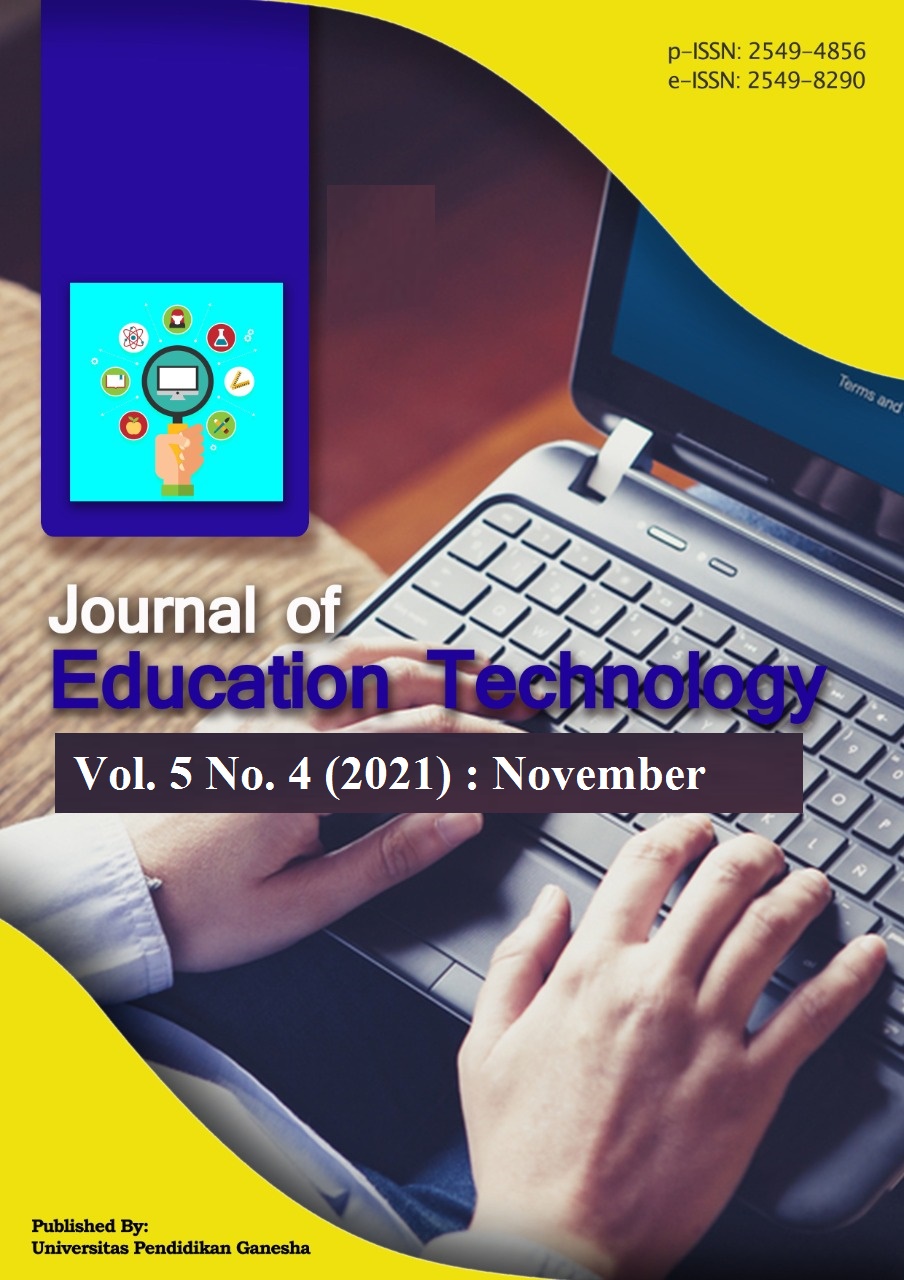Learners and Teacher Toward The Problem-Solving Based Learning Media
DOI:
https://doi.org/10.23887/jet.v5i4.33964Kata Kunci:
learning media, animation, problem-solvingAbstrak
Many students still have difficulty developing their ideas about explanatory texts while undergoing the learning process in class. This study aims to analyze the needs of students and teachers for the development of learning media in the form of animation writing explanatory texts based on problem-solving. This research is qualitative research that analyzes the first and design stages of research and development. The things that were analyzed were the needs of students and teachers for animated learning media to write problem-solving-based explanatory texts. From the data collected through questionnaires and interviews with 33 students and 1 Indonesian teacher. The technique used to analyze the data is descriptive qualitative and quantitative analysis. The research results show that animated learning media about problem-solving-based explanatory text writing can be an innovative medium for learning activities and can support students' and teachers' needs. This learning media is beneficial for both parties and can be accessed offline. Thus, learning media can be an alternative for the needs of teachers and students in learning and teaching writing explanatory texts.Referensi
Ainuzzaman, D. (2015). Pengembangan Media Pembelajaran Teks Eksplanasi Berbasis Adobe Flash Pro Cs5 pada Siswa Kelas VII Kurikulum 2013. Jurnal Pendidikan Bahasa Indonesia Universitas Negeri Yogyakarta, Vol. 2. 1–10.
Alessi, S., & Trollip, S. (2001). Multimedia for Learning, Methods, and Development. Bosten: Allyn & Bacon.
Anita, R. (2016). Pengembangan media pembelajaran teks anekdot berbasis animasi pada siswa kelas x smk. Jurnal Pendidikan Bahasa Indonesia Universitas Lampung, 1–31.
Arikunto, S. (2014). Prosedur Penelitian Suatu Pendekatan Praktik. Jakarta: Rineka Cipta.
Arsyad, A. (2016). Media Pembelajaran. Jakarta: PT Raja Grafindo Persada.
Asdar. (2016). Perangkat Pembelajaran Menulis Teks Eksplanasi Berbasis Model Problem Based Learning (Studi Pengembangan pada Siswa Kelas VIII SMP Negeri 8 Makasar). Jurnal Retorika Universitas Bosowa Makasar, Vol. 9. No. 2. 90–163.
Azmussya’ni, & Wangid, M. N. (2014). Peningkatan Keterampilan Menulis Menggunakan Pendekatan Proses dengan Media Gambar di SDN 3 Sakra. 2(1), 1–13.
Chun, R. (2017). Adobe Animate CC Classroom in a Book. Adobe Press.
Devetak, I., Glažar, S. A., & Vogrinc, J. (2010). The Role of Qualitative Research in Science Education. Eurasia Journal of Mathematics, Science and Technology Education, 6(1), 77–84.
Dini, R. D., Nurhayati. (2019). Pengembangan Lembar Kerja Peserta Didik (LKPD) Menulis Cerpen Berbasis Aplikasi Android. Jurnal Bahasa, Sastra, Dan Pengajarannya, 7, 2.
Labrecque, J. (2018). Creating Multiplatform Animations with Animate CC. Adobe MAX
Maesaroh, I. (2014). Peningkatan Pembelajaran Menulis Naskah Drama Menggunakan Media Film Pendek pada Siswa Kelas XI IPA SMA Muhammadiyah 1 Lumajang. 2(6), 627–635.
Masri, A. (2004). Tuntunan Menulis untuk Media Cetak (DIKTAT). Indralaya: FKIP Universitas Sriwijaya.
Palelupu, D. N., & Cholik, M. (2014). Pengembangn Media Pembelajan Berbasis Adobe Flash Cs5 Mata Diklat Gambar Teknik Dikelas X TPM SMK Krian 1 Sidoarjo. Jurnal Universitas Negeri Surabaya.
Priansa, D. J. (2019). Pengembangan Strategi dan Model Pembelajaran. Bandung: CV Pustaka Setia.
Pribadi, B. A. (2017). Media dan Teknologi dalam Pembelajaran. Jakarta: Kencana.
Puspitasari, E. H., & Rustono, H. B. (2014). Peningkatan Keterampilan Menulis Kembali Dengan Bahasa Sendiri Melalui Media Film Dongeng. Jurnal Pendidikan Bahasa Dan Sastra Indonesia, 3(1), 1–8.
Rusman. (2012). Belajar dan Pembelajaran Berbasis Komputer Mengembangkan Profesionalisme Guru Abad 21. Bandung: Alfabeta.
Sanaky, H. A. (2013). Media Pembelajaran Interaktif-Inovatif. Yogyakarta: Kaukaba Dipantara.
Sanjaya, W. (2012). Media Komunikasi Pembelajaran. Bandung: Kencana.
Seminar, K. B., Nurhadryani, P., & Nurmayasari, P. (2003). Penggunaan Animasi dan Multimedia pada Software Pembelajaran.
Sugianto. (2014). Pengembangan Bahan Ajar Menulis Teks Eksplanasi Bermuatan Kearifan Nusantara Berbasis Strategi Quip untuk Siswa Kelas VIII SMP/MTS. Jurnal Pendidikan Bahasa Pascasarjana Unisma. 1–8.
Sulistyasari, C. D. A., & Poedjiastoeti, S. (2013). Kelayakan multimedia interaktif untuk materi kesehatan dan keselamatan kerja di laboratorium kimia sma. UNESA Journal of Chemical Education. 30–35.
Unduhan
Diterbitkan
Cara Mengutip
Terbitan
Bagian
Lisensi
Authors who publish with the Journal of Education Technology agree to the following terms:
- Authors retain copyright and grant the journal the right of first publication with the work simultaneously licensed under a Creative Commons Attribution License (CC BY-SA 4.0) that allows others to share the work with an acknowledgment of the work's authorship and initial publication in this journal.
- Authors are able to enter into separate, additional contractual arrangements for the non-exclusive distribution of the journal's published version of the work (e.g., post it to an institutional repository or publish it in a book), with an acknowledgment of its initial publication in this journal.
- Authors are permitted and encouraged to post their work online (e.g., in institutional repositories or on their website) prior to and during the submission process, as it can lead to productive exchanges, as well as earlier and greater citation of published work. (See The Effect of Open Access)


















